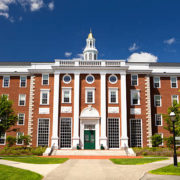The amount of Asian American students admitted to Harvard University is the highest its been in the last decade, as revealed by the university’s latest admission cycle results for its undergraduate class of 2023.
In announcing the demographics for the 1,950 students admitted to the university, 25.4% were Asian American. That’s up from last year’s admission cycle of 22.7% Asian Americans, which was just up less than a percent from years prior.
Not included in this year’s count were international students who made up 12.3% of the admitted class last year.
The number comes as federal Judge Allison Burroughs is expected to determine whether the university’s admission policies discriminate against Asian American applicants by taking the applicant’s race into account over factors like test scores and grades — a practice widely known and practiced with certain limitations as “affirmative action.”
In February, arguments from both sides of the lawsuit alleging the discrimination were heard in a federal court in Boston, repeating much of what was said during a nearly month-long trial that ended in November of last year.
The lawsuit dates back to 2014 when anti-affirmative action group Student for Fair Admissions sued the Ivy League university for allegedly violating Title VI of the Civil Rights Act, which prohibits racial discrimination in programs that receive federal financial assistance.
In 2014, the university admitted a percentage of 18.2% Asian Americans with the percentage slightly climbing up in the following years.
The group claimed that the university held Asian American students to a higher standard and used a subjective “personal rating” system that may be biased against Asian Americans to limit their admissions.
The U.S Department of Justice, in siding with the anti-affirmative action group, once called the scoring system “vague and illusory” and said it scored Asian American applicants lower on the personal rating than white applicants.
Harvard, which moved to dismiss the suit, has argued that it looks at university applicants holistically by taking into consideration a wide range of applicant information, including personal essays, which it uses “to understand that applicant’s full life story.”
In a previously made statement, it added that the personal rating system looked at information like where the student grew up, what opportunities or challenges they faced in their families or communities, and what “impact they might have both at Harvard and after they graduate, as citizens and leaders out in the world.”
Standing with the university, groups like Asian Americans Advancing Justice (Advancing Justice), have also described the university’s admission process as holistic and benefitting to underrepresented minority students, including Asian Americans.
Groups in support of Harvard have reasoned that numerical indicators like grade point averages and SAT scores — which data shows Asian American students excelling at — were not colorblind measures of merit.
According to College Board data released last December, the average combined SAT score went up 42 points among Asian Americans — a gain much higher than black and white students who saw gains of five points, and Latino and Native American students who saw a decline in points.
In a statement made last year, Advancing Justice said, “Research also confirms that the most promising students are not always the ones with the highest SAT scores or the best high school grades and that non-academic factors that predict success like grit, resourcefulness, creativity, and critical thinking are independent of (or even correlate negatively with) these traditional academic measures.”
With Burroughs expected to make her ruling in the upcoming months, many are looking at how the outcome may affect the future of affirmative action in higher education.






